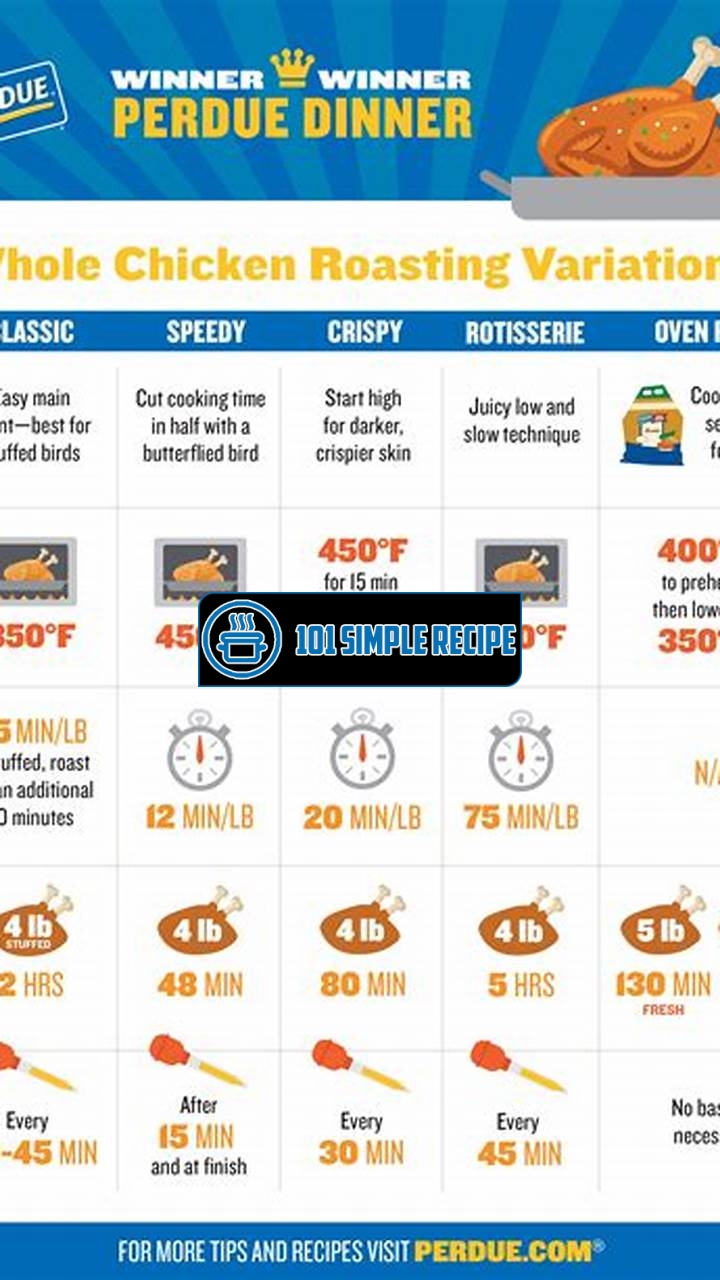Are you tired of serving undercooked or overcooked chicken? It’s time to master the art of perfect chicken temperature! Knowing the right temperature to cook your chicken to ensures that it is safe to eat, juicy, and full of flavor. In this comprehensive guide, we will take you through everything you need to know about achieving the perfect chicken temperature every time. Whether you’re a seasoned chef or a beginner in the kitchen, this article will equip you with the knowledge and techniques needed to cook chicken to perfection. So, let’s dig in and discover the secrets to achieving the perfect chicken temperature! ️

The Importance of Properly Cooking Chicken
Cooking chicken to the correct temperature is of utmost importance when it comes to ensuring food safety. Whether you’re grilling, baking, or frying chicken, you need to know the proper internal temperature to prevent the risk of foodborne illnesses. By understanding the significance of cooking chicken thoroughly, you can protect yourself and others from potential health risks.
Why Temperature Matters
The temperature at which you cook chicken plays a vital role in killing harmful bacteria, such as salmonella and campylobacter, that may be present in the meat. Cooking chicken to the correct temperature ensures that these pathogens are destroyed, making the chicken safe to consume. It’s crucial to achieve the proper internal temperature in order to eliminate any potential health hazards that undercooked chicken may pose.
️ Temperature tip: Always use a meat thermometer to accurately measure the internal temperature of the chicken. This will help you avoid guesswork and ensure that the chicken reaches the desired safety levels.
Health Risks of Undercooking Chicken
Undercooking chicken can result in a range of health risks. The most significant risk is food poisoning caused by bacterial contamination. Consumption of undercooked chicken can lead to symptoms such as nausea, vomiting, diarrhea, abdominal pain, and even fever. These symptoms can be severe and can last for several days, causing significant discomfort and distress.
⚠️ Note: According to the Centers for Disease Control and Prevention (CDC), each year in the United States, millions of people get sick due to foodborne illnesses, with chicken being a common source of contamination. Properly cooking chicken can effectively reduce the risk of these illnesses.
Safe Internal Temperatures for Chicken
Knowing the safe internal temperatures for chicken is crucial to ensure that it is cooked thoroughly and safe to eat. Different parts of the chicken require specific temperatures to reach the desired level of doneness. Here are some general guidelines:
Whole Chicken: The internal temperature of a whole chicken should reach at least 165°F (74°C) to ensure its safety.
Chicken Breasts: Chicken breasts should be cooked to an internal temperature of 165°F (74°C) to ensure they are fully cooked and safe to consume.
Chicken Thighs and Legs: Chicken thighs and legs should be cooked to an internal temperature of 170°F (77°C) to ensure they are cooked thoroughly.
By following these temperature guidelines, you can ensure that your chicken is cooked to perfection, minimizing the risk of potential health hazards associated with undercooked poultry.
↪️ Transition tip: It is important to note that these temperature recommendations are general guidelines. If you are using a recipe or specific cooking method, always follow the recommended cooking temperatures provided.
Mastering the art of perfect chicken temperature is not only essential for achieving delicious results but also for keeping yourself and others safe from foodborne illnesses. By understanding the importance of proper cooking temperatures, the risks of undercooking chicken, and the safe internal temperature guidelines, you can confidently cook chicken that is both flavorful and safe to consume.
Understanding Foodborne Illnesses
Foodborne illnesses are a serious concern when it comes to undercooked chicken. Consuming chicken that is not cooked to the proper temperature can result in various types of illnesses. It is crucial to understand these illnesses and take necessary precautions to prevent them.
Common Bacteria in Raw Chicken
Raw chicken is known to harbor several types of bacteria that can cause foodborne illnesses. Salmonella and Campylobacter are the most common bacteria found in raw chicken. These bacteria can cause severe gastrointestinal symptoms such as nausea, vomiting, diarrhea, and abdominal pain. It is important to note that these symptoms can be particularly dangerous for young children, pregnant women, and individuals with weakened immune systems.
Tip: Always handle raw chicken with caution to minimize the risk of bacterial contamination.
Effects of Foodborne Illnesses
Foodborne illnesses can have a significant impact on your health and well-being. In addition to the uncomfortable gastrointestinal symptoms mentioned earlier, these illnesses can also lead to dehydration, fever, and even hospitalization in severe cases. Furthermore, some bacterial infections can have long-term complications, including kidney damage and arthritis.
Tip: It is crucial to properly cook chicken to avoid the harmful effects of foodborne illnesses.
Prevention and Safe Handling Practices
To prevent foodborne illnesses associated with undercooked chicken, it is essential to follow safe handling practices and cook chicken to the appropriate temperature.
- Thoroughly wash your hands and utensils with hot, soapy water before and after handling raw chicken.
- Keep raw chicken separate from other ingredients to avoid cross-contamination.
- Cook chicken to an internal temperature of 165°F (75°C) to ensure all harmful bacteria are killed.
- Use a food thermometer to accurately measure the chicken’s internal temperature.
- Avoid consuming chicken with pink or bloody juices, as it indicates undercooking.
Tip: Proper food handling and cooking techniques are vital in preventing foodborne illnesses.
By understanding the types of foodborne illnesses associated with undercooked chicken, recognizing common bacteria found in raw chicken, and adopting prevention and safe handling practices, you can master the art of cooking chicken to perfection. Enjoy your delicious and safe meals!
The Science Behind Meat Thermometers
In order to master the art of cooking chicken to the perfect temperature, it is important to understand the science behind meat thermometers and their essential role in the cooking process. A meat thermometer is a device used to measure the internal temperature of meat, including chicken, to ensure it is cooked to a safe and optimal temperature.
Meat thermometers work by utilizing a temperature sensor that is inserted into the thickest part of the meat, typically the center. The sensor then measures the internal temperature, allowing you to accurately gauge the doneness of the chicken. Different types of meat thermometers exist, each with its own advantages and disadvantages.
Types of Meat Thermometers
There are several types of meat thermometers available on the market:
- Instant-read thermometers: These thermometers provide fast and accurate readings within seconds. They are perfect for determining the internal temperature of cooked chicken, as they can be easily inserted and give a quick temperature reading.
- Dial meat thermometers: These thermometers feature a dial that displays the temperature, making it easy to read and interpret. They are typically inserted into the chicken at the beginning of the cooking process and left in place until the chicken reaches the desired temperature.
- Wireless meat thermometers: These thermometers come with a probe that stays in the chicken while it cooks and a transmitter that sends the temperature readings wirelessly to a separate device, such as a smartphone or receiver. This allows you to monitor the temperature without opening the oven or grill.
Benefits of Using a Meat Thermometer
Using a meat thermometer offers several benefits when it comes to cooking chicken:
- Ensures food safety: Cooking chicken to the correct internal temperature is crucial in preventing foodborne illnesses. A meat thermometer helps you avoid undercooking, which can leave harmful bacteria in the meat, as well as overcooking, which can result in dry, tough chicken.
- Precision and consistency: With a meat thermometer, you can achieve precise and consistent results every time you cook chicken. This is especially important if you are aiming for specific levels of doneness, such as medium or well-done.
- Saves time and effort: By accurately gauging the internal temperature of chicken, you can avoid guesswork and prevent overcooking. This saves you time and effort, as you won’t have to rely on visual cues or make cuts to check the doneness of the chicken.
Proper Usage and Calibration
Proper usage and calibration of a meat thermometer are key in ensuring accurate temperature readings:
- Insert the thermometer correctly: When using a meat thermometer, insert it into the thickest part of the chicken, avoiding contact with bones or the cooking pan. This will give you the most accurate reading.
- Calibration: It is important to calibrate your meat thermometer regularly to ensure its accuracy. To do this, place the thermometer in a glass of ice water for instant-read thermometers or boiling water for dial thermometers. The thermometer should read 32°F (0°C) in ice water and 212°F (100°C) in boiling water. If the readings are off, follow the manufacturer’s instructions for recalibration.
- Cleaning and storage: After each use, clean your meat thermometer with warm, soapy water, or follow the manufacturer’s instructions. Proper storage in a safe and dry place will help maintain its functionality and prolong its lifespan.
Using a meat thermometer is a reliable and effective method for achieving the perfect chicken temperature. By understanding the science behind meat thermometers, utilizing the different types available, and following proper usage and calibration techniques, you can ensure that your chicken is cooked to perfection every time. So, don’t forget to equip yourself with a meat thermometer and enjoy delicious, perfectly cooked chicken!
Techniques for Cooking Chicken to Perfection
When it comes to cooking chicken, achieving the perfect temperature is crucial. Not only does it ensure that your chicken is safe to eat, but it also guarantees a delicious and juicy result. In this article, we will delve into different cooking methods and techniques that will help you master the art of cooking chicken to perfection.
Baking and Roasting
Baking and roasting are popular methods for cooking chicken as they allow for even heat distribution and result in tender and flavorful meat. Preheat your oven to the recommended temperature and place the chicken on a baking sheet or in a roasting pan. For a golden and crispy skin, rub the chicken with oil or butter, sprinkle your favorite seasonings, and place it in the oven. Remember to use a meat thermometer to check the internal temperature of the chicken. Cook until the thickest part of the meat reaches 165°F (74°C) for a safe and perfectly cooked chicken.
Grilling and Barbecuing
Grilling and barbecuing are excellent methods for imparting a smoky flavor to your chicken while ensuring a moist and succulent texture. Start by preheating your grill to medium-high heat and oil the grates to prevent sticking. Place the chicken on the grill and cook each side until grill marks are visible. To achieve the perfect internal temperature, use a meat thermometer to check if the thickest part of the chicken reaches 165°F (74°C). For an extra burst of flavor, baste the chicken with your favorite marinade or barbecue sauce while it cooks.
Sautéing and Pan-Frying
Sautéing and pan-frying are quick and easy methods for cooking chicken, resulting in a crispy exterior and a juicy interior. Heat a skillet or pan over medium-high heat and add a small amount of oil or butter. Once the oil is hot, add the chicken and cook until each side is golden brown. To check if the chicken is done cooking, use a meat thermometer to ensure the internal temperature reaches 165°F (74°C). Remember to flip the chicken occasionally for even browning and cooking.
In summary, mastering the art of perfect chicken temperature requires understanding the various cooking methods available. Whether you choose to bake and roast, grill and barbecue, or sauté and pan-fry your chicken, always keep food safety in mind by using a meat thermometer to ensure the chicken reaches the recommended internal temperature of 165°F (74°C). By following these techniques, you can enjoy a safe and delicious chicken dish every time.
Expert Tips for Juicy and Flavorful Chicken
When it comes to cooking chicken, achieving the perfect temperature is essential in order to ensure juicy and flavorful results. By following a few expert tips and tricks, you can master the art of cooking chicken to perfection.
Marinating and Brining
Marinating or brining your chicken before cooking can greatly enhance its flavor and tenderness. Marinating involves soaking the chicken in a mixture of oil, acid (such as vinegar or citrus juice), and spices, while brining involves submerging the chicken in a saltwater solution.
Pro tip: For maximum flavor, marinate your chicken for at least 2 hours or overnight in the refrigerator. Brining works best for larger cuts of chicken or whole chicken and should be done for a minimum of 1 hour.
Both methods help to tenderize the meat and infuse it with delicious flavors. The marinade or brine also helps to keep the chicken moist during the cooking process, resulting in succulent and juicy meat.
Using Herbs and Spices
Add an explosion of flavor to your chicken by using a variety of herbs and spices. Whether you prefer a mild or bold seasoning, there are endless options to choose from.
Pro tip: Experiment with different herb and spice combinations to create unique flavor profiles. Some popular options include garlic, rosemary, thyme, paprika, cumin, and chili powder. Feel free to get creative and adjust the seasonings to suit your taste preferences.
In addition to adding flavor, certain herbs and spices can also help tenderize the chicken. For example, ingredients like pineapple juice or papaya contain natural enzymes that break down proteins and make the meat more tender.
Resting and Carving
Once your chicken reaches the desired temperature, allow it to rest for a few minutes before carving. Resting the cooked chicken helps to retain its juices and ensures a moist and succulent texture.
Pro tip: Use a sharp knife to carve the chicken into even slices or pieces. This will make it easier to serve and maintain the chicken’s juiciness.
When carving the chicken, be sure to remove any excess fat or skin. This will not only improve the appearance of the dish but also reduce the overall fat content.
In conclusion, mastering the art of perfect chicken temperature is all about utilizing expert techniques to achieve juicy and flavorful results. By marinating or brining the chicken, using a variety of herbs and spices, and allowing the meat to rest before carving, you can elevate your chicken cooking skills to a whole new level.
Frequently Asked Questions
Thank you for reading our article on chicken temp cook! We hope you found it informative and helpful. If you have any more questions or need further clarification, please refer to the FAQs below!
| No. | Questions | Answers |
|---|---|---|
| 1. | What is the recommended internal temperature for cooking chicken? | The recommended internal temperature for cooking chicken is 165°F (74°C). This ensures that the chicken is fully cooked and safe to eat. |
| 2. | How do I check the internal temperature of chicken? | You can check the internal temperature of chicken by using a meat thermometer. Insert the thermometer into the thickest part of the chicken, avoiding bones, and make sure it reads 165°F (74°C) for proper doneness. |
| 3. | What are some popular cooking methods for chicken? | Some popular cooking methods for chicken include grilling, baking, roasting, and frying. Each method offers a unique flavor and texture to the chicken. |
| 4. | Can I marinate chicken before cooking? | Yes, marinating chicken before cooking can enhance its flavor and tenderness. You can use a variety of marinades and let the chicken sit in the marinade for at least 30 minutes to overnight in the refrigerator. |
| 5. | How can I ensure my chicken is juicy and not dry? | To ensure juicy chicken, you can brine it before cooking, baste it with butter or marinade while cooking, and avoid overcooking. Using a meat thermometer to accurately monitor the internal temperature is also crucial. |
| 6. | What are some delicious chicken recipes to try? | There are endless delicious chicken recipes to try, such as grilled lemon herb chicken, oven-baked garlic parmesan chicken, spicy honey glazed chicken wings, and creamy lemon garlic chicken pasta. Get creative and experiment with different flavors! |
Thank You for Reading!
We appreciate your time and interest in learning about chicken temp cook. We hope this article has provided you with valuable information to ensure your chicken is cooked to perfection. Remember, always prioritize food safety and enjoy the flavorful results of your cooking endeavors. Be sure to visit our website again for more informative articles and recipes. Happy cooking and bon appétit!
Jump to Recipe
Chicken Temp Cook

Learn the proper chicken temp cook to ensure safe and delicious results. Find answers to FAQs and discover a tasty chicken recipe!
- 4 chicken breasts
- 1 tsp salt
- 1 tsp black pepper
- 1 tsp paprika
- 2 cloves garlic (minced)
- 2 tbsp olive oil
- 1 lemon (juiced)
- Preheat the grill or oven to medium-high heat.
- Season the chicken breasts with salt, black pepper, and paprika.
- In a small bowl, combine the minced garlic, olive oil, and lemon juice to make the marinade.
- Coat the chicken breasts with the marinade, ensuring they are evenly coated. Let the chicken marinate for 15 minutes.
- Grill or bake the chicken breasts for approximately 6-8 minutes per side, or until the internal temperature reaches 165°F (74°C).
- Remove the chicken from the grill or oven and let it rest for a few minutes before serving. Serve with your favorite side dishes and enjoy!






